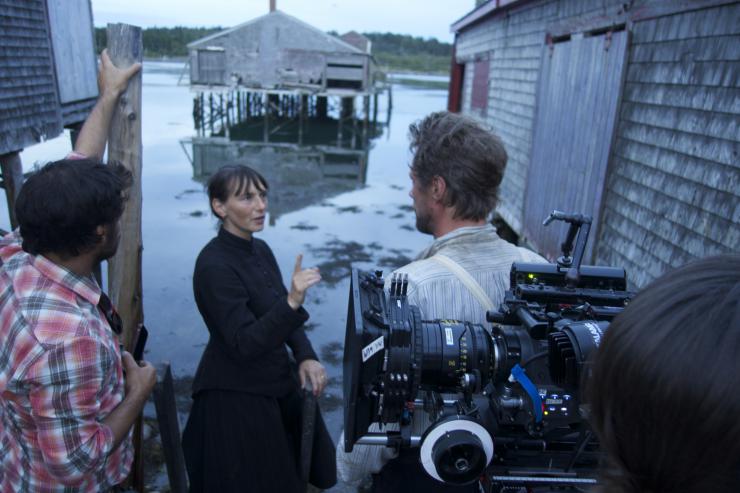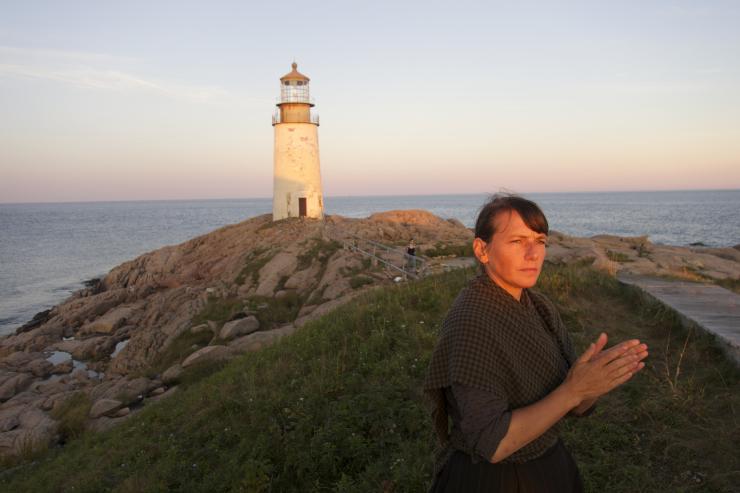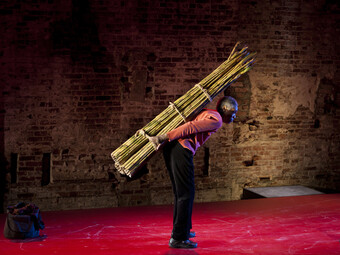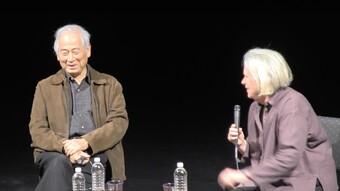History, Legacy, and Light
The Consciously-Embodied Art of Erica Fae
Erica Fae, barely into her forties, has been making theatre for over three decades. You can see her on television as a nude psychiatric asylum inmate in an episode of Boardwalk Empire or as Virginia Woolf in an episode of Doll & Em wandering a contemporary New York City street. You may have seen her on stage in a piece by Martha Clarke or some Fae has written, such as A Girl Joan about Joan of Arc or Take What Is Yours about the suffragette Alice Paul. You may know her as a teacher at the Yale School of Drama or New York University or movement-based workshops inspired by Grotowski and augmented by her own techniques honed over time. She now has directed her first full-length film To Keep The Light, soon coming to screen in a regional film festival. In solo and ensemble works completed and in progress, drawing upon a style of physical theatre influenced by many but that she has made her own, Erica Fae has made a career “embodying women who have come before and who have done incredible things.” Recently Erica and I had two far-reaching and energized discussions that outline past projects, current developments, and possibilities breaking just over the horizon.
Beginnings and Grotowski
“Why did it take me so long to realize that I’ve been doing this very thing since I was in the fourth grade?” Fae wondered during our first conversation in December at her sizable studio in the Westbeth Artists’ Housing in the West Village. Rather than simply deliver a book report on The Diary of a Young Girl, she embodied Anne Frank. “It was just natural for me to be Anne,” she recalled. At twelve she directed her own play inspired by the children’s photography book The Lonely Doll featuring a doll who lives in a Manhattan townhouse (humans nowhere to be seen) with a father and son set of stuffed bears. “I never identified with sweet, happy; everyone’s great kind of stories,” recalled Fae, who grew up with her mother and sister in Newbury on the Massachusetts coast near the clipper ship town of Newburyport, north of Gloucester, near the New Hampshire border.
Fae joined the local theatre company at seven and did four plays a year. “We did everything. We made the sets, we designed the posters. My whole life as a young girl, there was this rich, full, vibrant life that I would go to every day.” The company collaborated with other groups, including artists from Bread and Puppet who would come down and work with them. One summer a couple who had been in Poland for three years with the remnants of Jerzy Grotowski’s company, arrived to stay at the house of a friend of a friend who was away for the summer. The couple offered training to Fae’s theatre group. She was sixteen, and became enchanted with the movement-based Grotowski training they shared. Fae was accepted to NYU’s Experimental Theatre Wing to study with a Grotowski actor, received physical theatre-based acting training, created a theatre company with a boyfriend, went to the Edinburgh Fringe at twenty-three, and got on the BBC, all of which she described as “super precocious.”
Finding Women: Mary to Joan to Christine to Martha
“I get drawn to making things from historical characters.” At NYU she made a piece about Mary Haskell, a benefactress of Kahlil Gibran, mostly because she wanted to make a piece with a male colleague and the material fit. But after graduation and several international adventures, she returned to New York with a conviction that she needed the solo show “rite of passage.” She was inspired by a chance encounter with the Jules Bastien-Lepage portrait of Joan of Arc at the Metropolitan Museum of Art.
A Girl Joan, a “solo piece about the imagined heart-life of Joan of Arc,” covers the last two years of Joan’s life through Fae’s imaginings and edits of Joan’s trial transcripts. Fae plays all of the characters in what Fae calls “more than one in one,” creating a situation where “all of these characters co-exist within one meta character. For Joan, Archangel Michael and Saint Catherine and even her mother are in her head, so when I’m playing Joan, I’m playing Joan playing those characters.”
Research led Fae to writings by Christine de Pizan (1364–1430), the only woman to have written about Joan of Arc in her lifetime. Fae first attempted a theatre piece about her, Dreaming de Pizan, then created a short film in 2007, Christine. 1403. “I start getting into a period and researching and then, oh who’s this Christine de Pizan, and then, oh my god, she’s written so much. She’s the first known woman to have earned her living as a writer.” As with all Fae’s work, the pieces flow, one into the other. “The pieces themselves are kind of like a connective web that comes out of different research.”
Alice Paul and Take What Is Yours
Fae worked on a theatre piece on American suffragette Alice Paul for several years with several different collaborators before she met her director Jill A. Samuels. The two founded the theatre company anecdota that finally staged the piece in 2012 as Take What Is Yours. “First it was a solo, then I thought it was a duet, then I brought Jill on board because the collaboration team kept moving around.” The text for the piece is honed exclusively from testimony and publications from the time of the suffragist movement. “There were such extreme things said at that time about women, about society, that we thought we don’t want the audience to ever be confused.”
There are “more than one in one” dimensions in Fae’s performance as Alice Paul in a jail cell on a hunger strike. “All those moments when I’m playing different characters within the story that Alice is reliving, it’s in Alice’s brain. The performing of it gets a kind of tautness around the edges, wrapped up in a package of Alice’s psyche.”
The set of a wall with a constantly shifting opening into Paul’s cell and psyche, credited to director Jill A. Samuels (with the marvelous Deb O as set consultant), is an important character that the cast and crew named Martha. “She was a real good old girl,” said Fae. “She had her quirks and she and her wires needed to be rubbed with wax.” Though Martha isn’t around anymore, Fae mused about potential plans to recreate a more portable set for the show.
The difference between theatre and film, you make a play and there’s always this question, did it get its full life, it’s full journey? There are always these protective mommy feelings towards the thing. Did it really get to do its thing and sing its song fully? I’m trying to listen in for Alice. Do you have something else to say, Alice?
Abbie is actualizing feminist principles in her body, not thinking about it, not making a political statement about it. It’s a story of a woman who’s having a very innocent realization of her own equality.

Film: To Keep the Light
In research for a television pilot Samuels and Fae are developing, Fae stumbled upon stories of nineteenth-century women lighthouse keepers and a particular Rhode Island woman Ida Lewis, who kept the light alongside her husband. The main character Abbie in Fae’s new film To Keep the Light is a similar woman, a rare composite character among Fae’s creations. Rather than coming out of the education and philosophy of Alice Paul or Christine de Pizan, the feminism of Abbie, as of Joan, comes out of doing—she just is, just does, just perseveres. “Abbie is actualizing feminist principles in her body, not thinking about it, not making a political statement about it. It’s a story of a woman who’s having a very innocent realization of her own equality.”
In this project, Fae is actor, director, and producer, focusing on light, sound, acting, financing, and now distribution. Finding locations (actual lighthouse on Mistake Island, house built in Jonesport, and interiors at the Machiasport Historical Society Gates House), and casting the film were tremendous challenges with sometimes simple solutions. She didn’t assume she would play Abbie, but it became a philosophical resolution. “I’ve put myself in a film and I’ve said publicly: let’s look at faces that we don’t know. Let’s look at them and let them tell stories of people that we don’t know.”
Choosing to tell this story as a film rather than theatre piece came out of scope and visuals and the sound and rhythm of the sea. “The visuals and the tempo and energy of the sea, really live in the film, which I was very happy to experience. In this film, there’s a pacing that’s meant to be quite measured and bring you into the world.” Abbie has layers that are revealed though plot, sound design by Ryan Billia, composition by Caroline Shaw, and editing by Sabine Hoffman.
The film will be a featured film at the Florida Film Festival April 8–17, 2016.

Acrobat of the Heart: Grotowski’s Ideas in Practice
Fae’s training methods build on a long association with Stephen Wangh, leader of a four-week summer workshop “Acrobatics of the Heart” that “offers a holistic approach to acting with the body as a source” that explores physical exercises to open an actor's inner creativity and illuminates how people are working with Grotowski training now. Wangh took her under his wing at NYU and enticed her to teach with him at Naropa University in Boulder, Colorado. “I’m articulating the internal mind-emotional-body connect in a way that people dig,” Fae noted.
What I’m teaching is embodied consciousness or consciousness embodying or consciousness embodiment, training the actor to be more open, awake, conscious of every little thing that’s going on, constantly physicalizing, constantly embodying.
“I use Grotowski’s physical forms as kind of a foil,” Fae noted. “What I’m teaching is embodied consciousness or consciousness embodying or consciousness embodiment, training the actor to be more open, awake, conscious of every little thing that’s going on, constantly physicalizing, constantly embodying.” It’s not about stylized movements, she underscored; it’s about awareness. “I’m not self-conscious but conscious and purposeful with movement as part of the expressive tool of the actor in any character that I play. I’m aware, internally, of how she lives.”
Over the past year Fae has begun teaching her own workshops, produced by Synaesthetic Theatre Workshops, who produce the summer Acrobatics of the Heart workshop.
In the Works
Two projects are in the works now with Fae and Samuels: a television pilot based on a historical topic yet-to-be-revealed, and anecdota’s second theatre project for which the duo is starting with a staging concept and an illusion designer.
Finally, Fae is developing a script on her own. While To Keep the Light is “stoic, spare, minimalist, salty, steely” she described this new project as “verdant, green, lusty, playful.” She intends to focus on directing in this new film she envisions, with an ensemble cast and a main female character. “I feel her inside so that when I’m writing I can write from being inside the body of somebody. I bet everybody does. I bet most playwrights do. I think it’s different for a playwright who is not actually not also a performer. It’s just one step more imagined.”










Comments
The article is just the start of the conversation—we want to know what you think about this subject, too! HowlRound is a space for knowledge-sharing, and we welcome spirited, thoughtful, and on-topic dialogue. Find our full comments policy here